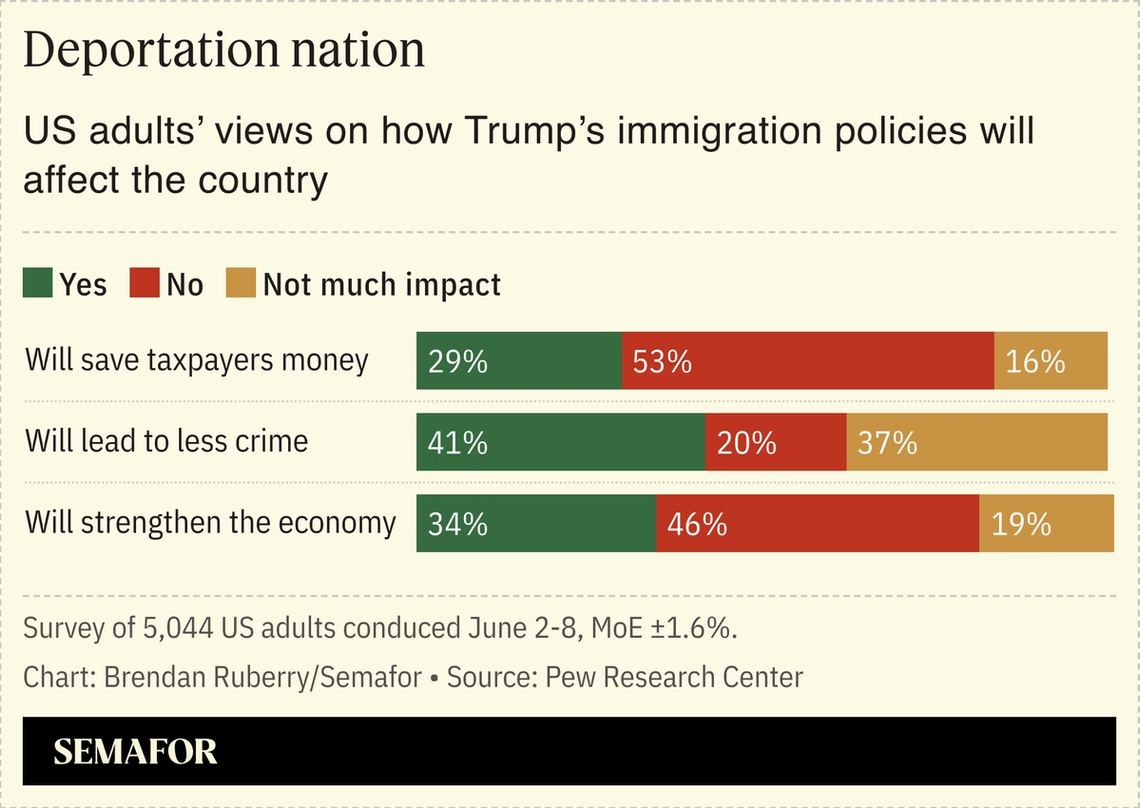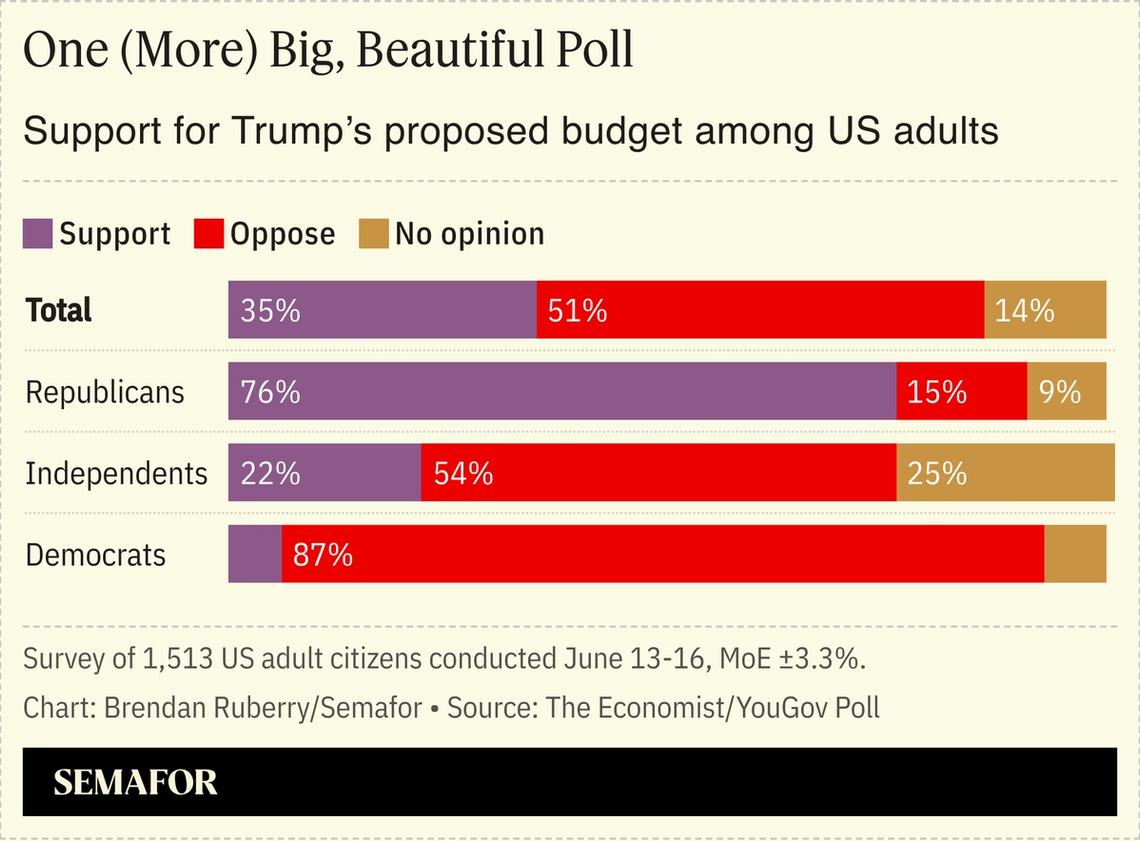 Polls The Trump administration’s deportation strategy is more aggressive than it was eight years ago, and more popular with the public. It’s got more support than the One Big Beautiful Bill Act, which clocks in at 29% here; by comparison, 57% of adults favor completion of a wall along the US-Mexico border. Some adults are also willing to put up with economic pain, if deportations cause it, even though that’s not implied by the administration. (It has been a heated topic in big cities, where economic activity by non-citizens has declined.) A plurality of adults, including most Republicans, believe that the deportations will lower crime, an argument Trump has now made for a decade. The idea that it will increase crime is concentrated among Democrats, who argue (with data) that non-citizens will cooperate more with police if they do not fear deportation.  Andrew Cuomo’s mayoral campaign has been at war with public polling, and the narratives that come from it. On social media, it mocked polling for groups like Data for Progress, which showed Mamdani surging ahead of Cuomo. It was happier to draw eyes to this New York-based pollster’s final look at the race, even though it confirms some of Mamdani’s momentum. He now ties Cuomo with white voters and beats him with Latinos, grabbing some of the anti-Cuomo vote from other progressive candidates. (The poll was conducted before Lander’s arrest.) Cuomo wins the final round on stronger support from black voters, carrying the Bronx 2-1. Progressives are hoping to close the gap with turnout, encouraged by big numbers in Brooklyn and Queens, where Mamdani has been strongest and young voters — his best demographic — are actually showing up.  Democrats have had no luck pulling the national news cycle where they want it — on the GOP’s tax and spending bill. Republicans have had no luck making it popular. The president’s overall job rating on the economy still lags his rating on immigration and his strong numbers from the first term. Every demographic group is skeptical, and Americans with incomes under $50,000 are most skeptical, opposing the bill by a 29-point margin. By a 19-point margin, those same voters (who are more racially diverse than wealthier adults) believe it should be illegal to interfere with ICE agents. There’s plenty of money behind ads selling the tax and spending bill, but it does not get the kind of cross-party support that Trump’s deportations do. Ads Adelita for Congress/YouTube Adelita for Congress/YouTube- La Gente for Grijalva, “His Voice.” Arizona Rep. Raul Grijalva’s death kicked off a special election for his seat, which his daughter Adelita entered almost immediately. Her paid messaging makes the connection very clear to voters: Yes, the 22-year congressman was her dad. “They’ve taught me not to give up,” the late congressman says in posthumous audio clips. “The fight’s not over.” The rest of the narration comes from his widow, Ramona, promising that their daughter will “fight with the same voice.”
- Daniel for Arizona, “Eyes Wide Open.” Daniel Hernandez was a 21-year old intern for Rep. Gabby Giffords when she was shot and nearly killed — surviving, in part, because he gave her first aid. That story has been at the center of his own campaigns, including the special election for Grijalva’s seat. His first ad is all bio: Growing up on Medicaid, surviving the shooting, learning to “fight like hell.”
- Adrienne for the People, “Rise Above.” Black New Yorkers were decisive in the 2013 and 2021 Democratic mayoral primaries, and one of the stories of the 2025 race has been every non-Andrew Cuomo candidate trying to win those voters. Adrienne Adams, one of the race’s three black candidates, speaks from a black church here, where the chorus lip-syncs along with Joubert Singers’ “Stand on the Word,” plays dominos at a community center, returns to Trump Tower (“I sued and blocked Trump from putting ICE on Rikers”) and says she’s “in it for us.”
Scooped!Few reporting topics are more sensitive than “what happens if these politicians die?” Paul Kane’s Washington Post column about how little Congress prepares for that — not just for deaths from old age, but from potential assassinations — tackles the subject and makes news. “Many lawmakers did not want to discuss the issue of possible mass killings of colleagues,” he writes. The near-death of the current GOP majority leader at a 2017 mass shooting didn’t really advance ideas to identify successors, who would continue the party’s control of lost seats, if the incumbents were murdered. That would require a constitutional amendment. It’s easier to do what members of Congress have been doing, and suggest that violence and threats are the other team’s fault. Next - four days until primaries in New York City
- eight days until the primary in Virginia’s 11th congressional district
- 27 days until the primary in Arizona’s 7th congressional district
- 139 days until off-year elections
- 500 days until the 2026 midterm elections
David RecommendsNicholas Confessore’s 11,000-word history of the ACLU and its trans rights litigation hit like a mortar shell, and is worth reading. The New York Times’s coverage of the topic has infuriated some LGBTQ+ activists, who blame the paper for platforming gender critical thinkers, arguments, and questionable research that might have otherwise stayed in conservative media — and out of courtrooms. But Confessore identifies the schism in the movement. Incrementalist advocates believed, and still believe, that trans rights can be won by humanizing trans people for voters who might not respect or understand them. In that, they were challenged by others who believed that “trans rights required a more fundamental social reimagining of sex and gender.” It’s a tricky story to tell — Sarah McBride as MLK, Chase Strangio as Malcolm X. And I’ve seen plenty of criticism of the piece from people who believe it overstates what the ACLU’s options were in Skrmetti, or that it presents a one-sided view of the medical debate. Read it with a pinch of salt, but read it. |